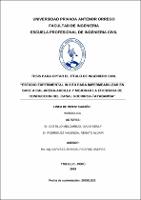Estudio experimental in situ para impermeabilizar en base a cal-arena-arcilla y mejorar la eficiencia de conducción del canal gochirca - tayabamba

View/
Download
(application/pdf: 4.615Mb)
(application/pdf: 4.615Mb)
Date
2019Author(s)
Castillo Melgarejo, Isaias Kenly
Rodríguez Valencia, Renato Aldair
Metadata
Show full item recordAbstract
La presente tesis tuvo como objetivo principal realizar un estudio experimental in situ para impermeabilizar en base a cal-arena-arcilla y mejorar la eficiencia de conducción del canal Gochirca-Tayabamba.
El desarrollo del proyecto se realizó en tres etapas, la primera, consistió en calcular el caudal del canal mediante medición directa (método del cubo) siendo este de 4.61 L/s, hallar la pérdida de caudal del canal por infiltración siendo este de 1.41 L/s (30.56 % de caudal total), calcular la eficiencia de conducción hidráulica obteniendo un resultado de 69.41 % y determinar las diferentes proporciones del mortero hecho a base de arcilla, arena y cal, las cuales tuvieron las siguientes proporciones respectivamente: Muestra 1 (70%, 20%, 10%), muestra 2 (60%, 30%, 10%), muestra 3 (50%, 25%, 25%).
En la segunda etapa para determinar las propiedades mecánicas de la arcilla y arena se realizó los ensayos en laboratorio obteniendo su clasificación respectivamente según SUCS arcilla de baja plasticidad (CL) y arena pobremente graduada (SP), y según la clasificación AASHTO material arcilloso A4 y material granular del grupo A-1-b; y por último se realizó el ensayo de infiltración cuyo proceso inició con la excavación in situ de 03 calicatas con una profundidad y diámetro de 0.30 m cada una, luego se revistió con el mortero en estudio con un espesor de 0.03 m, se agregó agua para observar y anotar 2 veces al día su descenso, el periodo de evaluación duró 8 semanas (56 días) y al final se analizó los resultados del ensayo y se determinó cual es la dosificación más eficiente contra la infiltración, siendo esta la muestra N°1 con una dosificación: 7:2:1.
La tercera y última etapa, consistió en realizar el ensayo de infiltración en un tramo de canal de 2.8 m revestido con la mejor dosificación de mortero, primero se midió el caudal inicial (4.07 L/s) y final (3.93 L/s) del tramo sin revestimiento, luego se procedió a medir el caudal inicial (4.05 L/s) y final (4.04 L/s) del tramo revestido para determinar el nivel de infiltración del caudal, siendo este de 0.01 L/s; y finalmente se comparó con los resultados obtenidos de las mediciones hechas en el canal sin revestir, hallando así una eficiencia de 99.8 %. Se concluyó que se puede aumentar la eficiencia de conducción del agua de un canal impermeabilizándolo con el mortero con proporciones: 70 % arcilla, 20 % arena y 10 % cal, debido a que, la arcilla es un material con bajo nivel de permeabilidad, la arena ayuda para mejorar la consistencia y trabajabilidad, y la cal es un ligante natural siendo capaz de unir diferentes materiales y mejorando la adherencia de éstos. The main objective of this thesis was to carry out an experimental in situ study to waterproof the Gochirca-Tayabamba canal based on lime-sand clay and improve its conduction efficiency.
The development of the project was carried out in three stages, the first, consisted in calculating the flow of the channel by means of direct measurement (bucket method) being this one of 4.61 L/s, to find the loss of flow of the channel by infiltration being this one of 1.41 L/s (30.56 % of total flow), to calculate the efficiency of hydraulic conduction obtaining a result of 69.41 % and to determine the different proportions of the mortar made with clay, sand and lime, which had the following proportions respectively: Sample 1 (70%, 20%, 10%), sample 2 (60%, 30%, 10%), sample 3 (50%, 25%, 25%).
In the second stage to determine the mechanical properties of the clay and sand, laboratory tests were carried out, obtaining their classification respectively according to SUCS low plasticity clay (CL) and poorly graded sand (SP), and according to the AASHTO classification, clay material A4 and granular material of group A-1-b; and finally, the infiltration test was carried out, the process of which began with the excavation in situ of 03 calicatas with a depth and diameter of 0.30 m each, then coated with the mortar under study with a thickness of 0.03 m, water was added to observe and note twice a day its decline, the evaluation period lasted 8 weeks (56 days) and at the end the results of the test were analyzed and it was determined which is the most efficient dosage against infiltration, being this sample No. 1 with a dosage: 7:2:1.
The third and last stage consisted of performing the infiltration test in a 2.8 m section of channel lined with the best mortar dosage, first the initial flow (4.07 L/s) and final flow (3.93 L/s) of the section without lining was measured, then proceeded to measure the initial flow (4.05 L/s) and final (4.04 L/s) of the lined section to determine the level of infiltration of the flow, being this of 0.01 L/s; and finally it was compared with the results obtained from the measurements made in the unlined channel, thus finding an efficiency of 99.8 %.
It was concluded that it is possible to increase the water conduction efficiency of a waterproofing channel by using mortar with proportions: 70% clay, 20% sand and 10% lime, due to the fact that clay is a material with a low level of permeability, sand helps to improve consistency and workability, and lime is a natural binder being able to join different materials and improving their adherence.
Collections
- Ingeniería Civil [1260]

